Page 142 of 251
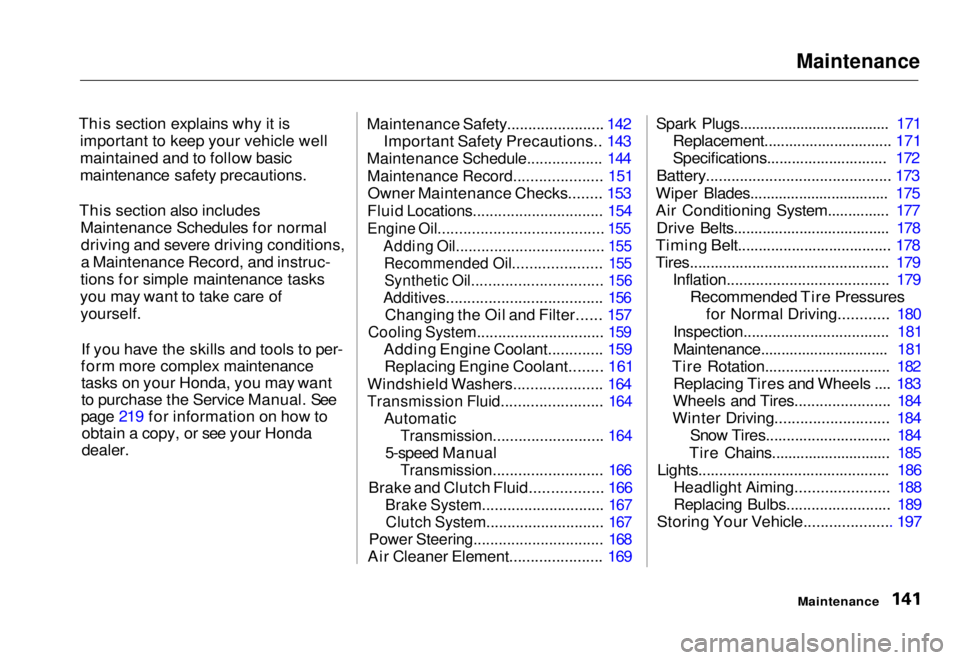
Maintenance
This section explains why it is important to keep your vehicle well
maintained and to follow basic
maintenance safety precautions.
This section also includes Maintenance Schedules for normaldriving and severe driving conditions,
a Maintenance Record, and instruc-
tions for simple maintenance tasks
you may want to take care of yourself.
If you have the skills and tools to per-
form more complex maintenance tasks on your Honda, you may want
to purchase the Service Manual. See
page 219 for information on how to obtain a copy, or see your Honda
dealer.
Maintenance Safety....................... 142
Important Safety Precautions.. 143
Maintenance Schedule.................. 144
Maintenance Record..................... 151
Owner Maintenance Checks........ 153
Fluid Locations............................... 154
Engine Oil....................................... 155 Adding Oil................................... 155Recommended Oil..................... 155Synthetic Oil............................... 156
Additives..................................... 156
Changing the Oil and Filter...... 157
Cooling System.............................. 159
Adding Engine Coolant............. 159Replacing Engine Coolant........ 161
Windshield Washers..................... 164
Transmission Fluid........................ 164
Automatic
Transmission.......................... 164
5-speed Manual
Transmission.......................... 166
Brake and Clutch Fluid................. 166
Brake System............................. 167Clutch System............................ 167
Power Steering............................... 168
Air Cleaner Element...................... 169 Spark Plugs..................................... 171
Replacement............................... 171
Specifications............................. 172
Battery............................................ 173
Wiper Blades.................................. 175
Air Conditioning System............... 177 Drive Belts...................................... 178
Timing Belt..................................... 178
Tires................................................ 179 Inflation....................................... 179
Recommended Tire Pressures
for Normal Driving............ 180
Inspection................................... 181
Maintenance............................... 181
Tire Rotation.............................. 182
Replacing Tires and Wheels ....
183
Wheels an d
Tires....................... 184
Winter Driving........................... 184 Snow Tires.............................. 184
Tire Chains............................. 185
Lights.............................................. 186 Headlight Aiming...................... 188
Replacing Bulbs......................... 189
Storing Your Vehicle..................... 197
MaintenanceMain Menu s t
Page 143 of 251

Maintenance Safety
Regularly maintaining your vehicle is
the best way to protect your
investment. Proper maintenance is essential to your safety and the
safety of your passengers. It will also
reward you with more economical,
trouble-free driving and help reduce
air pollution. This section includes instructions for
simple maintenance tasks, such as
checking and adding oil. Any service
items not detailed in this section should be performed by a Honda
technician or other qualified mechanic. Some of the most important safety
precautions are given here. However,
we cannot warn you of every conceivable hazard that can arise in
performing maintenance. Only youcan decide whether or not you
should perform a given task.
Maintenance
Improperly maintaining this
vehicle or failing to correct a problem before driving can
cause a crash in which you can be seriously hurt or killed.
Always follow the inspection and maintenancerecommendations and
schedules in this owner's manual. Failure to properly follow
maintenance instructions and
precautions can cause you to
be seriously hurt or killed.
Always follow the procedures and precautions in this owner'smanual.Main Menu Table of Contents s t
Page 154 of 251
Owner Maintenance Checks
You should check the following
items at the specified intervals.
If
you are
unsure of how to perform
any check, turn to the
page given.
Engine oil level
— Check every
time you
fill the fuel tank. See
page 111.
Engine coolant level
— Check the
radiator reserve
tank every time
you fill the fuel tank. See page 112.
Windshield washer fluid
— Check
the level
in the reservoir monthly.
If weather conditions cause you to
use the washers frequently, check
the reservoir each time you stop
for fuel. See page 164.
Automatic transmission
— Check
the flui d
level monthly. See page
164.
Brakes — Check the fluid level
monthly. Se e
page 167.
Tires
— Check the tire pressure
monthly. Examin e
the tread for
wear and foreign objects. See page 180.
Lights — Check the operation of
the headlights ,
parking lights,
taillights, high-mount brake light,
turn signals, brake lights, and
license plate lights monthly. See
page 187.
MaintenanceMain Menu Table of Contents s t
Page 155 of 251
Fluid Locations
AUTOMATIC
TRANSMISSIONFLUID DIPSTICK
(Yellow loop)
(Including CVT)
COOLANT
RESERVOIR
BRAKE FLUID
(Gray cap)
CLUTCH FLUID
(5-speed Manual
Transmission only)
(Gray cap)
ENGINE OIL
FILL CAP
POWER STEERING
FLUID (Red cap)
WASHER FLUID (Blue cap)
ENGINE OIL DIPSTICK
(Orange loop)
MaintenanceMain Menu Table of Contents s t
Page 156 of 251
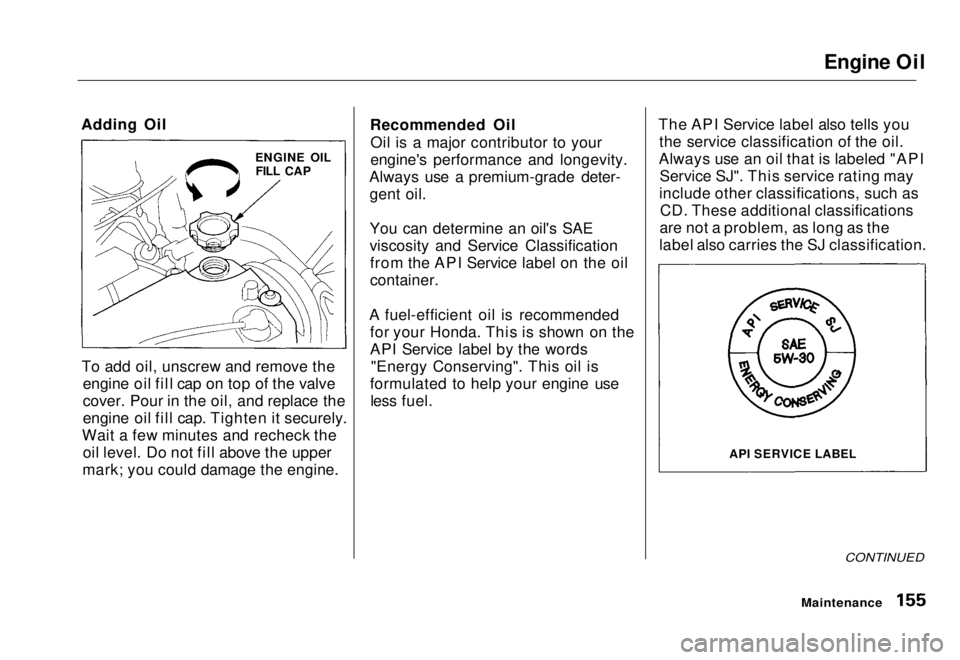
Engine Oil
Adding Oil
To add oil, unscrew and remove the engine oil fill cap on top of the valve
cover. Pour in the oil, and replace the
engine oil fill cap. Tighten it securely.
Wait a few minutes and recheck the oil level. Do not fill above the upper
mark; you could damage the engine. Recommended Oil
Oil is a major contributor to your
engine's performance and longevity.
Always use a premium-grade deter- gent oil.
You can determine an oil's SAE
viscosity and Service Classificationfrom the API Service label on the oil
container.
A fuel-efficient oil is recommended for your Honda. This is shown on the
API Service label by the words"Energy Conserving". This oil is
formulated to help your engine use less fuel. The API Service label also tells you
the service classification of the oil.
Always use an oil that is labeled "API Service SJ". This service rating may
include other classifications, such as CD. These additional classifications
are not a problem, as long as the
label also carries the SJ classification.
CONTINUED
Maintenance
ENGINE OIL
FILL CAP
API SERVICE LABELMain Menu Table of Contents s t
Page 157 of 251
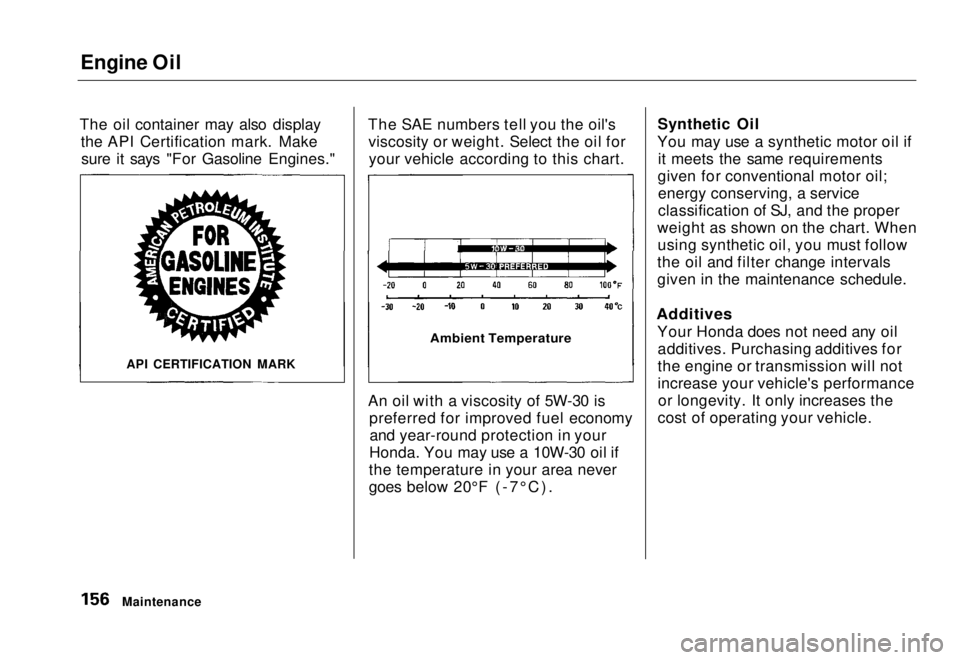
Engine Oil
The oil container may also display the API Certification mark. Makesure it says "For Gasoline Engines." The SAE numbers tell you the oil's
viscosity or weight. Select the oil foryour vehicle according to this chart.
An oil with a viscosity of 5W-30 is preferred for improved fuel economyand year-round protection in your
Honda. You may use a 10W-30 oil if
the temperature in your area never
goes below 20°F (-7°C). Synthetic Oil
You may use a synthetic motor oil if it meets the same requirements
given for conventional motor oil; energy conserving, a service
classification of SJ, and the proper
weight as shown on the chart. When using synthetic oil, you must follow
the oil and filter change intervals
given in the maintenance schedule.
Additives
Your Honda does not need any oiladditives. Purchasing additives for
the engine or transmission will not
increase your vehicle's performanceor longevity. It only increases the
cost of operating your vehicle.
Maintenance API CERTIFICATION MARK
Ambient TemperatureMain Menu Table of Contents s t
Page 158 of 251
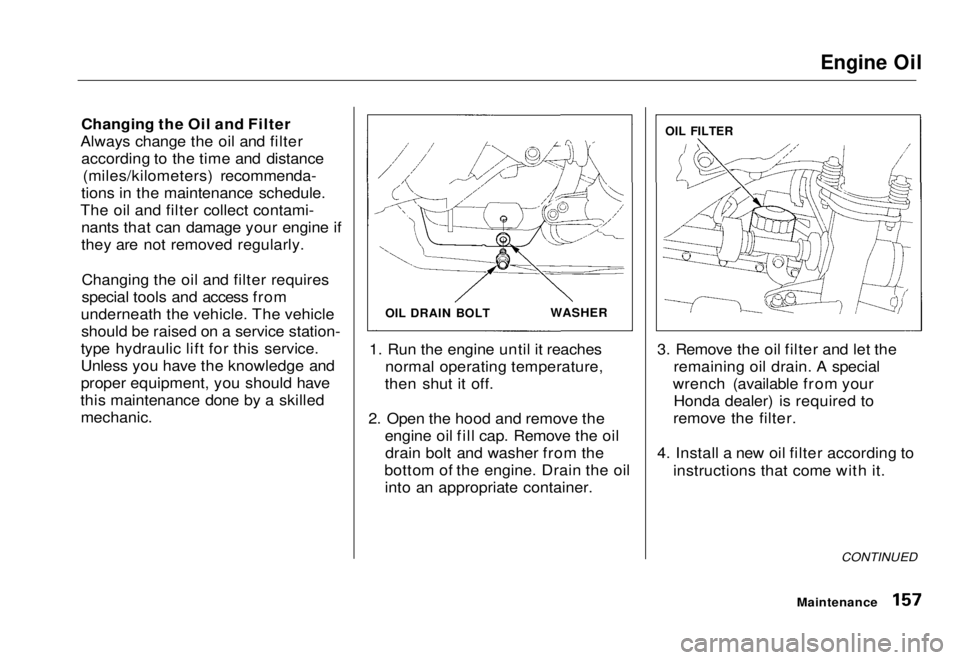
Engine Oil
Changing the Oil and Filter
Always change the oil and filter according to the time and distance (miles/kilometers) recommenda-
tions in the maintenance schedule.
The oil and filter collect contami- nants that can damage your engine if
they are not removed regularly.
Changing the oil and filter requires
special tools and access from
underneath the vehicle. The vehicle should be raised on a service station-
type hydraulic lift for this service.
Unless you have the knowledge and
proper equipment, you should have
this maintenance done by a skilled
mechanic.
1. Run the engine until it reaches
normal operating temperature,
then shut it off.
2. Open the hood and remove the engine oil fill cap. Remove the oildrain bolt and washer from the
bottom of the engine. Drain the oil into an appropriate container. 3. Remove the oil filter and let the
remaining oil drain. A special
wrench (available from your Honda dealer) is required to
remove the filter.
4. Install a new oil filter according to instructions that come with it.
CONTINUED
Maintenance
OIL DRAIN BOLT
WASHER
OIL FILTERMain Menu Table of Contents s t
Page 159 of 251
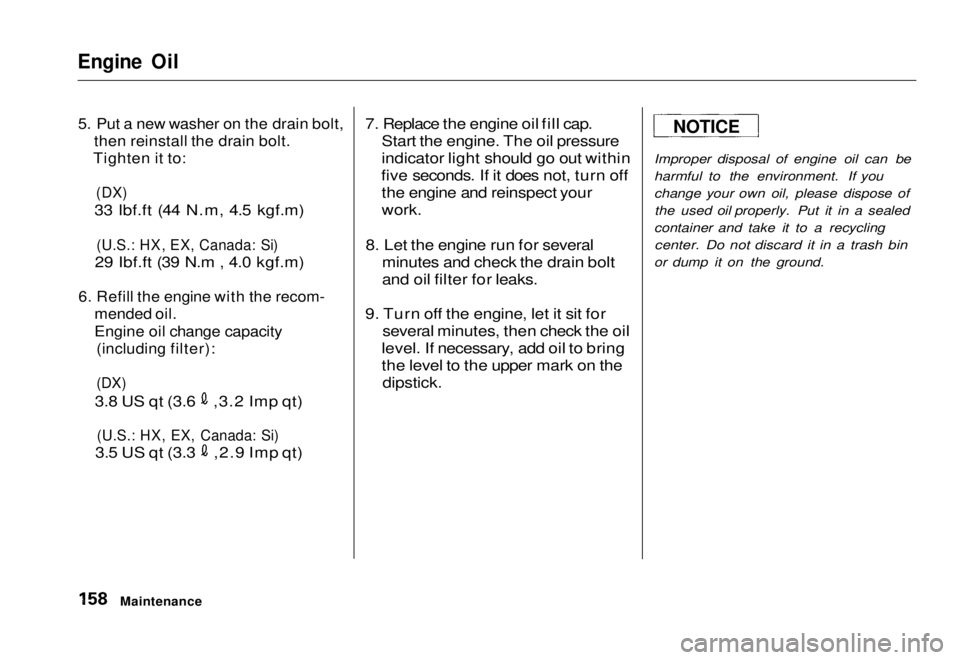
Engine Oil
5. Put a new washer on the drain bolt,
then reinstall the drain bolt.
Tighten it to:
(DX)
33 lbf.ft (44 N.m, 4.5 kgf.m)
(U.S.: HX, EX, Canada: Si)
29 Ibf.ft (39 N.m , 4.0 kgf.m)
6. Refill the engine with the recom-
mended oil.
Engine oil change capacity
(including filter):
(DX)
3.8 US qt (3.6 ,3.2 Imp qt)
(U.S.: HX, EX, Canada: Si)
3.5 US qt (3.3 ,2.9 Imp qt) 7. Replace the engine oil fill cap.
Start the engine. The oil pressure
indicator light should go out within
five seconds. If it does not, turn off the engine and reinspect your
work.
8. Let the engine run for several minutes and check the drain bolt
and oil filter for leaks.
9. Turn off the engine, let it sit for several minutes, then check the oil
level. If necessary, add oil to bring
the level to the upper mark on the
dipstick.
Improper disposal of engine oil can be
harmful to the environment. If you
change your own oil, please dispose of
the used oil properly. Put it in a sealed
container and take it to a recycling
center. Do not discard it in a trash bin
or dump it on the ground.
Maintenance
NOTICEMain Menu Table of Contents s t